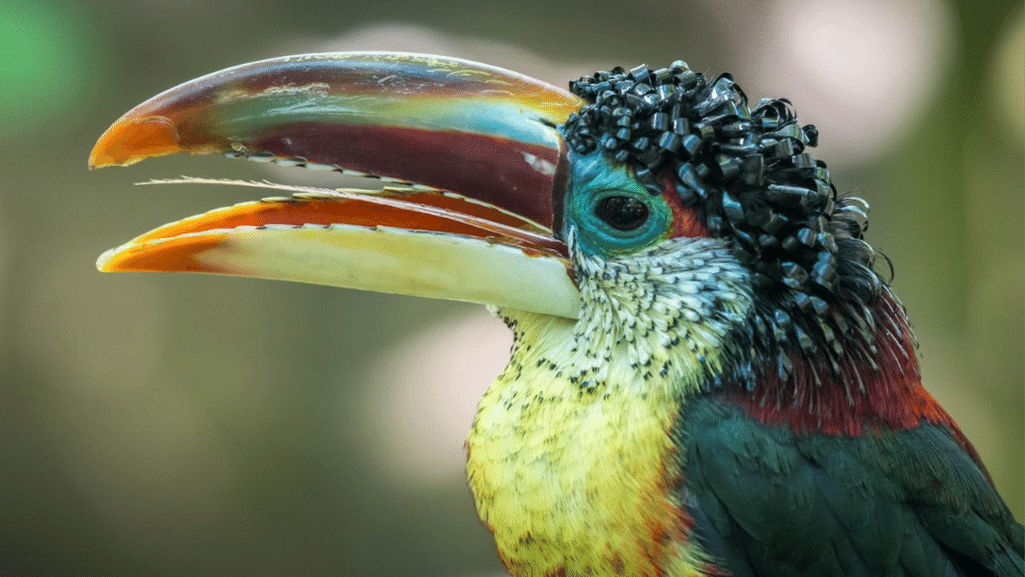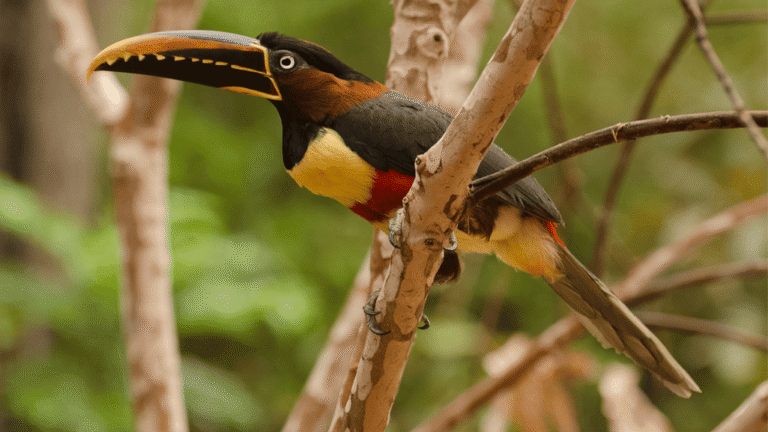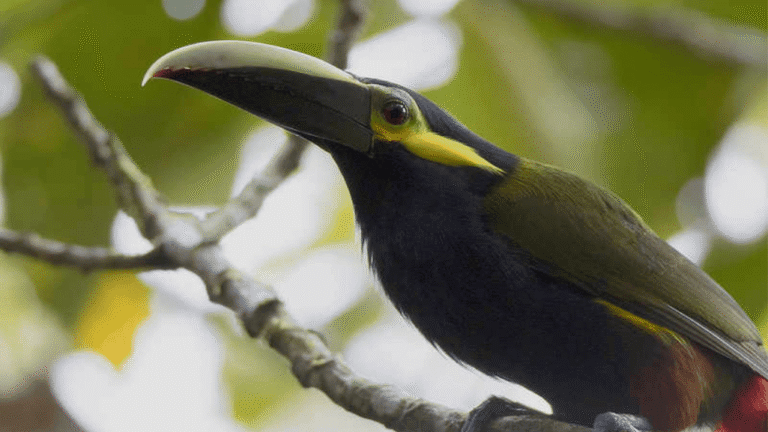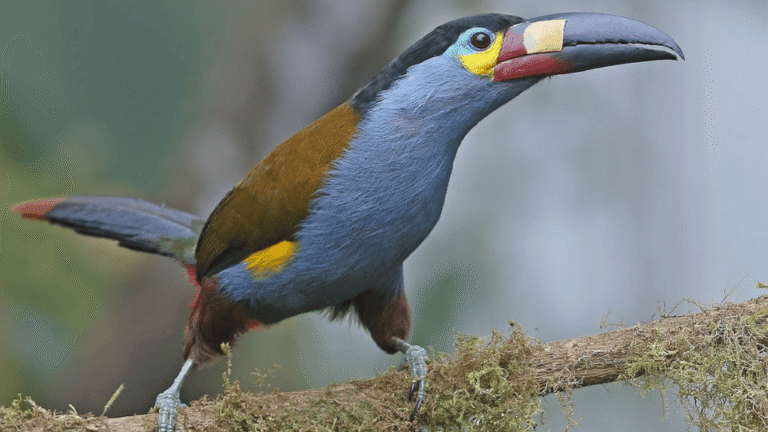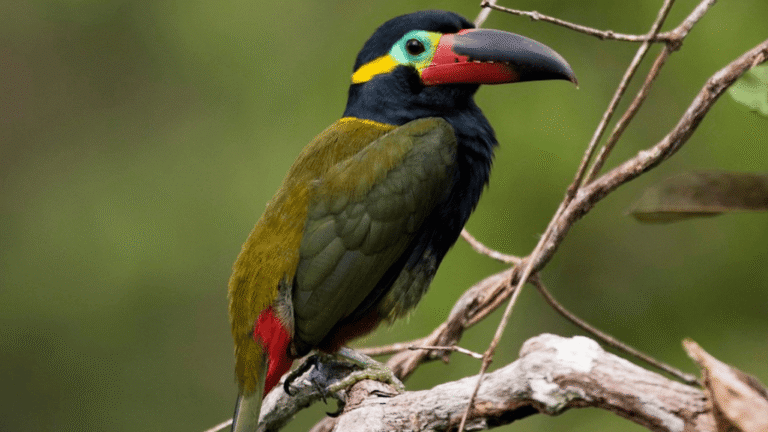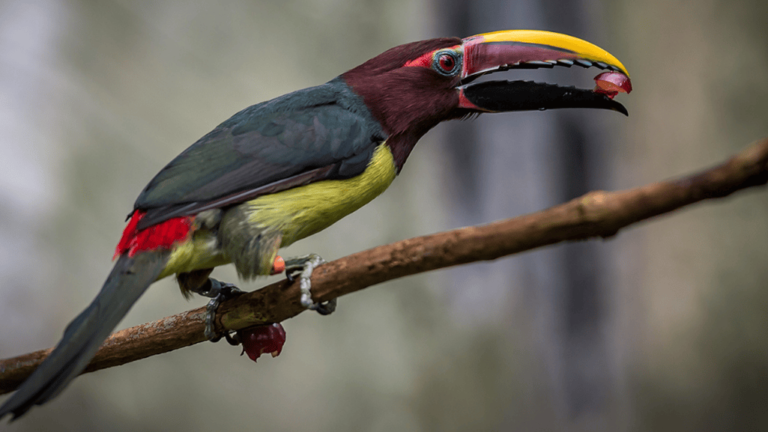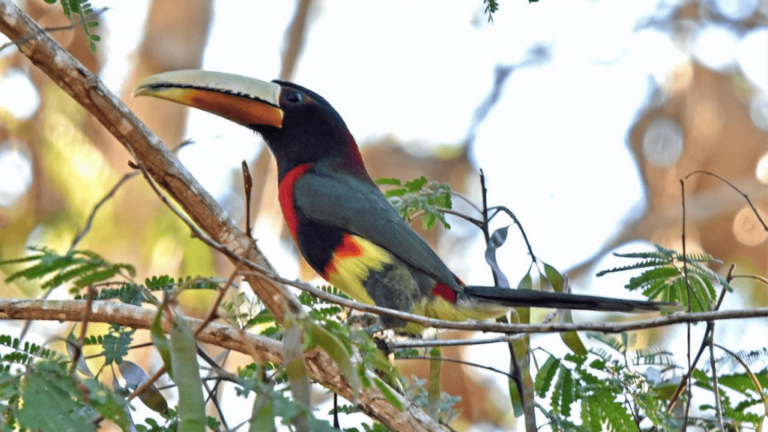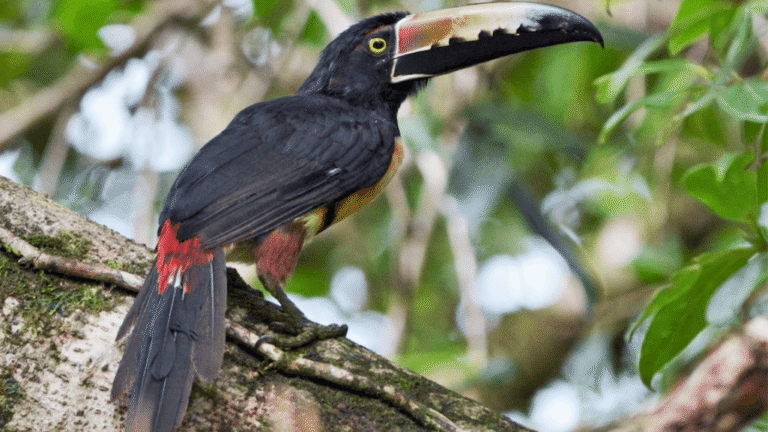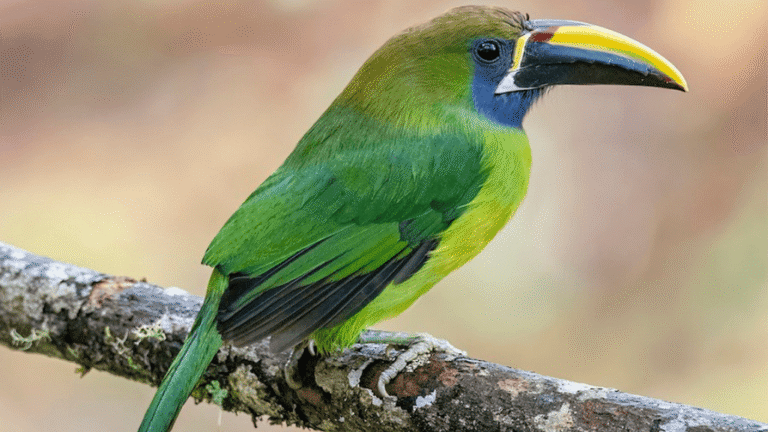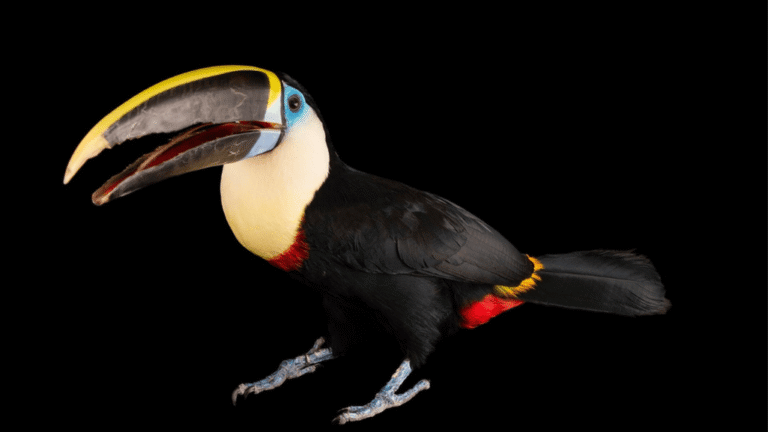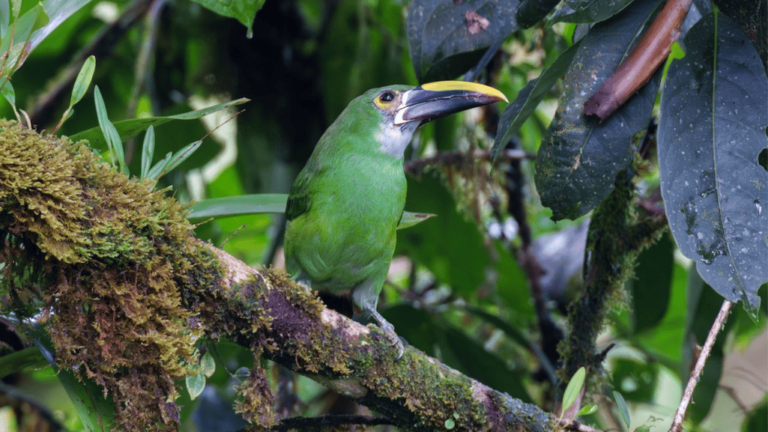The Curl-crested Aracari, also known as the curl-crested araçari, is an exotic bird species native to the tropical forests of South America. With its vibrant plumage and curled crest, it is often compared to a colorful toucan, making it a popular subject for birdwatching and wildlife photography. This unique bird, found in the lush rainforests of Peru, Brazil, and Bolivia, is not only a visual delight but also plays a crucial role in bird conservation efforts.
Key Takeaways:
- The Curl-crested Aracari is a tropical bird species with a unique curled crest.
- It is commonly found in the tropical forests of South America, including Peru, Brazil, and Bolivia.
- This colorful toucan-like bird is a favorite subject for birdwatching and wildlife photography enthusiasts.
- Conservation efforts are essential to protect the Curl-crested Aracari and its fragile forest habitat.
- Observing and capturing images of this exotic bird offers a rewarding experience for nature enthusiasts.
Description of the Curl-crested Aracari
The Curl-crested Aracari is a fascinating bird species with a unique appearance and captivating behaviors. Let’s dive into the details of this remarkable bird:
Appearance
The Curl-crested Aracari is a medium-sized bird, measuring between 16 to 18 inches (41 to 46 cm) in length. Its most striking feature is the shiny, black curled feathers on its head, which resemble pieces of plastic or curled ribbon. The bird also showcases blue bare skin around its eyes and whitish-yellow facial feathers with hardened black tips. Its bill is patterned and multicolored, with an orange tip. The back of the Curl-crested Aracari is red, while the breast is yellow with red blotches and a single red band. The tail varies in color but tends to have a dominant greenish-bronze hue. Notably, females have a shorter bill compared to males.
Size
The Curl-crested Aracari is considered a medium-sized bird, typically measuring between 16 to 18 inches (41 to 46 cm) in length.
Behavior
The Curl-crested Aracari is known for its social behavior and affinity for forming groups. It often roosts and sleeps alongside up to five adults and their fledged offspring in the same nesting hole. The bird primarily feeds on fruit but may also consume eggs and nestlings. When foraging, the Curl-crested Aracari is often seen in groups of up to a dozen individuals. Additionally, this bird communicates through a range of vocalizations, encompassing various speeds, depths, and intensities.
Diet
The Curl-crested Aracari has a diverse diet that mainly consists of fruit. However, it may also include eggs and nestlings as part of its food intake.
Communication
The Curl-crested Aracari utilizes an array of vocalizations to communicate with others of its kind. These vocalizations can vary in speed, depth, and intensity, producing a wide range of sounds from fast to slow, deep to soft, and even grunt-like vocalizations.
Reproduction
The Curl-crested Aracari reproduces by nesting in abandoned tree hollows, typically created by woodpeckers. The female lays three to four white, elliptical-shaped eggs. Both parents take turns incubating the eggs for approximately 16 days. Once the chicks hatch, the parents provide care and feed them until they are ready to fledge, which occurs around six weeks after hatching.
| Curl-crested Aracari Description | |
|---|---|
| Size | 16-18 inches (41-46 cm) |
| Appearance | Medium-sized bird with curled black feathers on the head, blue bare skin around the eyes, patterned multicolored bill, red back, yellow breast with red blotches, and a greenish-bronze tail |
| Behavior | Social bird that sleeps in groups, primarily feeds on fruit, and communicates through a range of vocalizations |
| Diet | Fruit, eggs, nestlings |
| Reproduction | Nests in abandoned tree hollows, lays 3-4 white eggs, both parents incubate eggs for 16 days, parents care for chicks until they fledge at around 6 weeks |
Habitat and Range of the Curl-crested Aracari
| Habitat | Range |
|---|---|
| The Curl-crested Aracari inhabits tropical moist lowland forests in western Amazonia. | Its range includes southern Peru (south of the Amazon), western Brazil, and northern Bolivia. |
| Specific Locations | |
| Within its range, it can be spotted in various protected areas such as: | |
| Tambopata National Reserve, Peru | |
| Noel Kempff Mercado National Park, Bolivia | |
| Cristalino State Park, Brazil | |
The Curl-crested Aracari is predominantly found in the southwestern section of the Amazon Basin, with the Amazon River serving as its northern range limit. It thrives in tropical moist lowland forests that are rich in biodiversity. These forests provide the bird with a suitable habitat for foraging, nesting, and breeding.
In Peru, the Tambopata National Reserve is a prime location to spot the Curl-crested Aracari. This protected area is located in the Madre de Dios region and covers a vast expanse of rainforest. The reserve is renowned for its incredible birdlife, making it an ideal destination for birdwatchers and wildlife enthusiasts.
In Bolivia, the Noel Kempff Mercado National Park offers a glimpse into the diverse ecosystem where the Curl-crested Aracari thrives. Situated in the easternmost part of the country, the park spans over 15,000 square kilometers and encompasses various habitats, including dense forests and savannas.
Brazil’s Cristalino State Park, near Alta Floresta in the state of Mato Grosso, is another notable location to observe this unique bird species. The park is recognized for its exceptional biodiversity, making it a haven for birdwatchers, photographers, and nature lovers.
These protected areas play a crucial role in conserving the habitat of the Curl-crested Aracari and supporting the overall biodiversity of the Amazon rainforest. By safeguarding these regions, we can ensure the preservation of this extraordinary bird species and promote the sustainable management of its habitat for future generations.
Behavior of the Curl-crested Aracari
The Curl-crested Aracari, a highly social bird, demonstrates fascinating behavior patterns in its daily activities. From nesting to foraging and communication, this species exhibits intriguing traits that contribute to its unique charm.
Social Behavior
The Curl-crested Aracari is known for its gregarious nature, forming groups and roosting together with other individuals. It is commonly observed that up to five adults, along with their fledged offspring, sleep in the same nesting hole, fostering a sense of community and support.
Nesting and Diet
When it comes to nesting, the Curl-crested Aracari relies on abandoned tree hollows, often created by woodpeckers. Within these cozy homes, the female lays three to four white, elliptical-shaped eggs, which are incubated by both parents. In terms of diet, this species primarily feeds on a variety of fruits, but it can also consume eggs and nestlings when the opportunity arises.
Foraging Behavior
Foraging is a group activity for the Curl-crested Aracari, with individuals often joining forces to search for food. These foraging groups can consist of up to a dozen birds, utilizing their sharp beaks to pluck ripe fruits from trees in a coordinated manner.
Communication
The Curl-crested Aracari uses a range of vocalizations to communicate within its social group. The variety of sounds includes fast and slow patterns, deep and soft tones, and even grunt-like calls. By utilizing this repertoire of vocal cues, the bird maintains social cohesion and conveys essential messages to its fellow aracaris.
| Behavior | Description |
|---|---|
| Social Behavior | Forms groups and roosts together |
| Nesting and Diet | Utilizes abandoned tree hollows for nesting; primarily feeds on fruits, but may consume eggs and nestlings |
| Foraging Behavior | Forages in groups, up to a dozen individuals |
| Communication | Uses a range of vocalizations, including fast, slow, deep, soft, and grunt-like sounds |
Reproduction of the Curl-crested Aracari
One of the fascinating aspects of the Curl-crested Aracari’s life cycle is its reproductive behavior. Let’s explore how these birds go about nesting, laying eggs, incubating, providing parental care, and eventually, the fledging process.
Nesting and Egg Laying
The Curl-crested Aracari usually builds its nest in abandoned tree hollows, often those created by woodpeckers. These natural cavities provide a safe and secure environment for the breeding pair and their offspring. The female aracari lays an average of three to four white, elliptical-shaped eggs within the nest.
Incubation and Parental Care
Both the male and female Curl-crested Aracari take turns incubating the eggs. This cooperative breeding behavior ensures that the eggs receive constant warmth and protection. The incubation period lasts approximately 16 days, during which the parents diligently attend to their precious clutch.
Chick Development and Fledging
After the incubation period, the chicks hatch as blind and naked hatchlings. Here, the dedicated parents step up their role, engaging in parental care by providing them with food, typically regurgitated fruits. The chicks gradually grow and develop, relying entirely on their parents for sustenance and protection.
Around six weeks after hatching, the young Curl-crested Aracaris, known as fledglings, are ready to leave the nest. At this stage, they possess feathers and have acquired some basic flying skills. Fledging marks an important milestone in their life, as they embark on their independent journey.
| Reproductive Milestones | Description |
|---|---|
| Nesting | Building nests in abandoned tree hollows |
| Egg Laying | 3-4 white, elliptical-shaped eggs per clutch |
| Incubation | Approximately 16 days of shared incubation duty |
| Parental Care | Feeding and protecting the hatchlings until fledging |
| Fledging | Leaving the nest and developing independent skills |
The Curl-crested Aracari’s nesting and reproductive behavior showcases the dedication and cooperation between the male and female birds. By ensuring the survival of their offspring and fostering their growth, these extraordinary birds contribute to the continuity of their species.
Distribution and Conservation Status of the Curl-crested Aracari
The Curl-crested Aracari is primarily found in the southwestern section of the Amazon Basin, with its distribution spanning from southern Peru to western Brazil and northern Bolivia. The bird inhabits tropical moist lowland forests, making these regions its primary habitat.
While the Curl-crested Aracari is generally considered rare to uncommon, it can be regularly observed at specific localities within its range. Notably, the species is frequently encountered in protected areas such as the Tambopata National Reserve in Peru, the Noel Kempff Mercado National Park in Bolivia, and the Cristalino State Park near Alta Floresta in Brazil.
When it comes to conservation status, the Curl-crested Aracari is listed as Least Concern on the IUCN Red List. This classification indicates that the bird is currently not considered to be at significant risk of extinction. However, it is important to note that conservation efforts remain crucial to ensure the long-term survival of this unique species and its fragile forest habitat.
| Conservation Status | IUCN Red List |
|---|---|
| Least Concern | Not at significant risk of extinction |
Protected Areas where the Curl-crested Aracari can be found:
- Tambopata National Reserve, Peru
- Noel Kempff Mercado National Park, Bolivia
- Cristalino State Park, Brazil
Importance for Birdwatching and Wildlife Photography
The Curl-crested Aracari is a highly sought-after subject for birdwatchers and wildlife photographers. With its unique appearance and vibrant plumage, this tropical bird species captivates the attention of enthusiasts. Observing and capturing images of the Curl-crested Aracari in its natural habitat offers a rewarding and thrilling experience.
For birdwatchers, spotting the Curl-crested Aracari is a dream come true. Its colorful and striking features make it stand out among other bird species in South America. Watching this magnificent creature navigate through the tropical rainforests is a memorable and awe-inspiring sight.
Wildlife photographers are equally drawn to the Curl-crested Aracari. Its vibrant plumage, including the curled crest, provides a visually captivating subject. Photographers from around the world venture into the tropical forests of South America to capture unique shots of this exquisite bird species.
Whether through binoculars or the lens of a camera, birdwatching and wildlife photography enthusiasts can witness the beauty and charm of the Curl-crested Aracari up close. Its presence in the diverse ecosystem of tropical forests highlights the importance of conservation efforts to protect both the species and its habitat.
For those passionate about avian diversity and nature’s wonders, encountering the Curl-crested Aracari in its natural environment is a truly enriching experience.
Curl-crested Aracari Photo Opportunities
| Place | Photography Opportunities |
|---|---|
| Tambopata National Reserve, Peru | Pristine rainforests offer exceptional chances of capturing the bird’s vibrant colors amidst lush greenery. |
| Noel Kempff Mercado National Park, Bolivia | A paradise for wildlife photographers, the park provides opportunities to photograph the Curl-crested Aracari in its natural habitat. |
| Cristalino State Park, Brazil | This biodiverse park offers birdwatchers and photographers a chance to observe and document the Curl-crested Aracari’s behavior. |
Conclusion
The Curl-crested Aracari is a remarkable and unique bird species found in the tropical forests of South America. With its curled crest and vibrant plumage, this bird is a captivating subject for birdwatchers and wildlife photographers alike. While the Curl-crested Aracari is currently listed as Least Concern on the IUCN Red List, it is essential to prioritize conservation efforts to ensure the long-term survival of this beautiful bird and its delicate forest habitat.
By raising awareness about the Curl-crested Aracari and supporting bird conservation initiatives, we can play a vital role in the preservation of this extraordinary species. The tropical forests that this bird calls home are not only crucial for the survival of the Curl-crested Aracari but also for numerous other plant and animal species. Protecting these habitats is vital for maintaining the biodiversity and ecological balance of these unique ecosystems.
Whether you are an avid birdwatcher or a passionate wildlife photographer, observing the Curl-crested Aracari in its natural habitat is an awe-inspiring experience. It serves as a reminder of the untamed beauty that exists within our world’s tropical forests. Let us continue to appreciate and celebrate the wonder of the Curl-crested Aracari, while also working towards its conservation, for the benefit of future generations and the overall health of our planet.
Frequently Asked Questions
What is the Curl-crested Aracari?
The Curl-crested Aracari is a tropical bird species belonging to the Ramphastidae family. It is a colorful toucan-like bird with a curled crest of shiny black feathers on its head.
Where is the Curl-crested Aracari found?
The Curl-crested Aracari is native to the tropical moist lowland forests of western Amazonia in southern Peru, western Brazil, and northern Bolivia.
What is the size and appearance of the Curl-crested Aracari?
The Curl-crested Aracari is a medium-sized bird, measuring 16-18 inches (41-46 cm) in length. It has a curled crest of shiny black feathers on its head, blue bare skin around the eyes, and a patterned, multicolored bill.
What is the habitat of the Curl-crested Aracari?
The Curl-crested Aracari inhabits tropical moist lowland forests in western Amazonia, specifically in regions of southern Peru, western Brazil, and northern Bolivia.
How does the Curl-crested Aracari behave?
The Curl-crested Aracari is a social bird that forms groups and roosts together. It feeds primarily on fruit and forages in groups. It communicates through a range of vocalizations.
How does the Curl-crested Aracari reproduce?
The Curl-crested Aracari nests in abandoned tree hollows and the female lays three to four white eggs. Both parents share the duty of incubating the eggs and caring for the chicks until they fledge.
What is the conservation status of the Curl-crested Aracari?
The Curl-crested Aracari is currently listed as Least Concern on the IUCN Red List, indicating that it is not considered to be at significant risk of extinction.
Why is the Curl-crested Aracari important for birdwatching and wildlife photography?
The Curl-crested Aracari’s unique appearance and vibrant plumage make it a sought-after subject for birdwatchers and wildlife photographers. Observing and capturing images of this exotic bird species in its natural habitat offers a rewarding experience.
Why is the conservation of the Curl-crested Aracari important?
Conservation efforts are crucial to ensure the long-term survival of the Curl-crested Aracari and its fragile forest habitat. Supporting conservation initiatives and raising awareness can contribute to the preservation of this extraordinary species for future generations.




